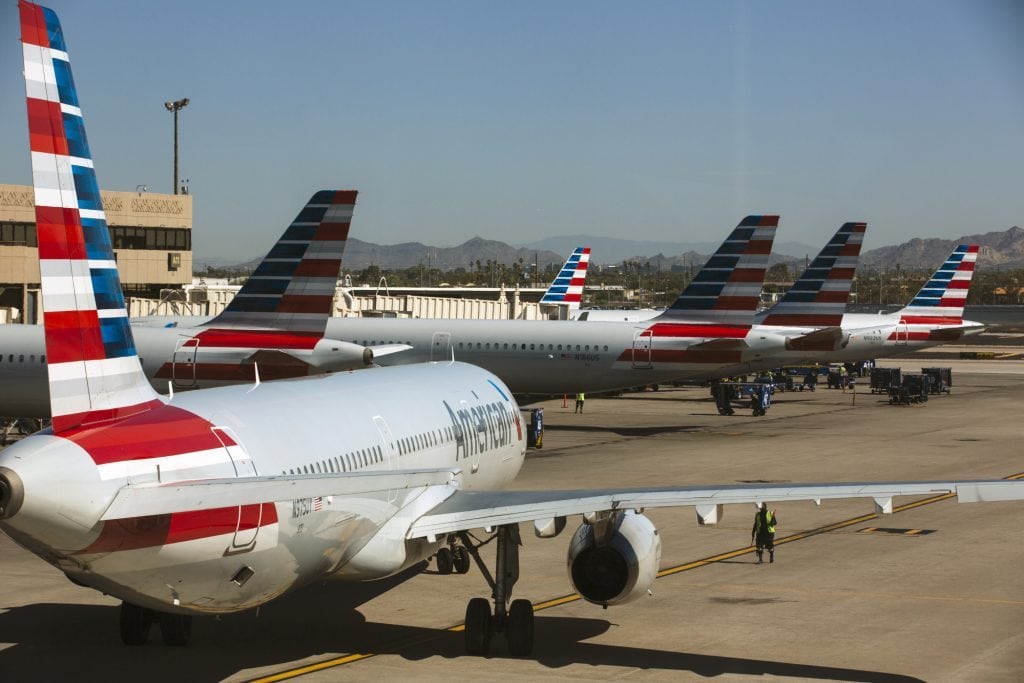Skift Take
American Airlines suggests that it's not planning for the Boeing 737 Max to return to flying until the late summer or fall. But the airline is still positive this year will be better than last. That shouldn't be too hard.
American Airlines has pushed out the Boeing 737 Max’s expected return to service until June. But CEO Doug Parker anticipates that the aircraft’s grounding could extend into the late summer or early fall, depriving the airline of a key piece of its network planning during the peak summer travel period.
When the Boeing 737 Max returns is of critical importance to American, which has 24 of the jets parked, and has planned its domestic network around the longer range and increased passenger capacity of the Max. American expected to add another 26 of the 737 Max by the end of this year, and executives remained positive that Boeing will deliver those aircraft quickly after the grounding is lifted.
The Boeing 737 Max has been grounded worldwide in the wake of two accidents, in 2018 and 2019, linked to malfunctioning flight-control software. Recently, Boeing said it had identified new issues with the Max that could delay regulators approving the aircraft’s return to service. Boeing has warned airlines that regulatory approval may not come until mid-year.
Further complicating the problem for American — and Southwest and United, which are the other two Boeing 737 Max operators in the U.S. — is that Boeing now says pilots who fly the Max need simulator training. One of the key selling points for the Max was Boeing’s assertion that pilots already qualified to fly older generations of the Boeing 737 would not need new simulator training, which is both costly and time consuming for airlines. And as a result, few dedicated Max simulators exist. American remains outwardly confident that it will have trained a sufficient number of its pilots to helm the Max when it is cleared to fly.
American reached a confidential settlement with Boeing for losses incurred by the 737 Max’s grounding. “The financial cost of the Max grounding should be borne by Boeing’s shareholders, not American’s,” SkifParker told analysts on the airline’s fourth-quarter earnings call on Thursday.
“We will continue to hold Boeing accountable for future financial damages to protect our company and our shareholders,” he added.
American also is being more proactive in removing flights operated by Boeing 737 Max from its schedule earlier. Last year, the carrier lost high-yielding last-minute business travel by having to operate smaller aircraft in the Max’s stead. “There has been a huge transfer of [market] share from carriers that operate the Max to carriers that don’t operate the Max, and we saw that in the fourth quarter,” said Vasu Raja, American’s head of network planning.
Despite its problems with the Max, American reported stronger results in the fourth quarter and full-year 2019 than it did in 2018. Revenues were up by more than 3 percent to $11.3 billion for the quarter and rose about 3 percent to $45.8 billion for the year. Fourth-quarter profits compared with the same quarter in 2018 rose 28 percent in the quarter to $414 million.
American is coming off a rough year. In 2019, it was beset by labor woes, primarily with its mechanics that drove up costs and reduced on-time performance. Parker said the airline’s labor travails are largely behind it, with only one collective bargaining agreement left to be negotiated this year. On-time performance improved in the fourth quarter.
“We achieved record results for combined mainline and regional on-time departures,” president Robert Isom noted. American lagged behind competitors Delta Air Lines and United Airlines by almost every metric in 2019, but Parker said it expects to close the margin gap with United in “a couple of years.” Catching up with powerhouse Delta could be more difficult, which Parker attributed to “structural advantages” with Delta’s hubs — Atlanta remains one of the strongest hubs in the world.
The Max grounding helped American in one important way: It was forced to concentrate its flying from three of its most important hubs, Dallas/Ft. Worth, Charlotte, N.C., and Chicago O’Hare, emphasizing connecting traffic from those airports. In all three hubs, passenger traffic rose, Isom said. The airline is focusing its efforts on Dallas/Ft. Worth and Charlotte, helped by gate expansions at those airports, for much of its future network growth.
A bright spot in American’s network was Latin America. Despite geopolitical issues, such as Argentine political uncertainty last year and the relatively anemic growth in several of the region’s largest economies, demand in Latin American for air travel remained high. In fact, unit revenue – a key industry financial metric – rose by 10 percent in the quarter, compared with 2018.
Demand from Brazil, Mexico, and Argentina was strong, although the Caribbean was flat for the year. American is the largest U.S. carrier in Latin America, but last year it suffered a blow, when Delta swooped in and invested more than $1 billion in American’s longterm regional partner Latam. Isom said the relationship will formally end at the end of this month, but American is “the best partner for future relationships.”
The Daily Newsletter
Our daily coverage of the global travel industry. Written by editors and analysts from across Skift’s brands.
Have a confidential tip for Skift? Get in touch
Tags: american airlines, boeing 737 max
Photo credit: A ground crew member directs an American Airlines Group Inc. plane preparing to taxi on the tarmac. Angus Mordant / Bloomberg
